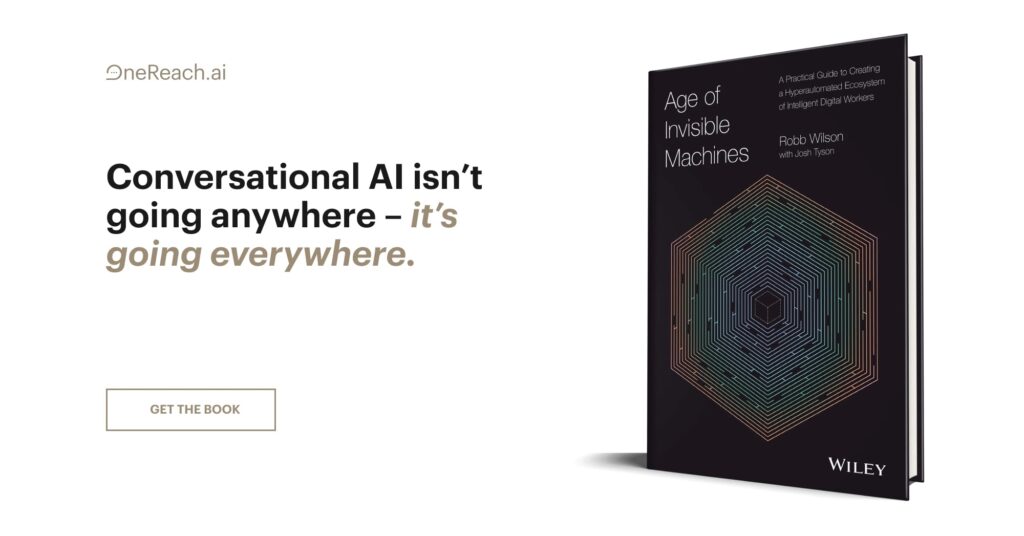Maybe it seems like the more conversations you have about conversational AI, the more confusing it becomes. It’s tempting to think of it as nothing more than a new interface that experience designers can apply their skills to, but it’s something much larger than that. Conversational AI represents a vast, emergent set of technologies obscured by layers of hype and misinformation.
There’s a very reasonable sense of urgency surrounding its adoption and implementation within the business community, but putting it to work requires a fuller understanding of what it actually entails.
When you start thinking about conversational AI in the right way, you begin to see that it’s not a piece of technology to be wielded, it’s really a business strategy for building an ecosystem where various technologies are sequenced to automate tasks and processes in ways that surpass what humans alone are capable of. Gartner calls this evolved state of automation “hyperautomation,” and by their estimation it’s an “unavoidable market state.” For experience designers it also hints at something of a white whale: the interface that truly disappears. When it’s orchestrated properly, conversational AI eliminates all of the existing barriers that get between humans and machines.
The easiest way to illustrate what conversational AI is might be providing clarity about what it is not. Here are some of the more persistent myths about conversational AI that you should expel from your mind as soon as possible. Conversation AI isn’t going anywhere. In fact, very soon, it will be going everywhere. It’s crucial that every organization across every vertical has a strategy surrounding it, so make sure you know what’s real and what’s isn’t.
- Conversational AI is just talking to machines
No. Not even close. Natural Language Understanding (NLU) is actually one of the smaller pieces of the conversational AI puzzle. Getting computers to the point where they are contextualizing the things that people say has required massive leaps in technology, but that doesn’t mean it’s the most effective way to interact with users. Though, at present, only a handful of organizations are leveraging this technology at high levels, experiences in a state of hyperautomation go beyond the limits of talking and typing, incorporating gestures, facial expressions, visual aids, and sounds. By Deloitte’s definition, conversational AI brings together eight pieces of technology: NLP, intent recognition, entity recognition, fulfilment, voice-optimized responses, dynamic text-to-speech, machine learning, and contextual awareness. In that context, comparing NLU to conversational AI is like comparing a bicycle wheel to an automobile.
- Business-minded people know enough to pick the best conversational AI platforms
Given the complexity illustrated above, the business minds in your organization can’t make conversational AI decisions alone. This is a collaborative effort that should draw on expertise from various disciplines within your organization. You’ll need input from those who understand the technology you currently have in place, those who have relationships with your customer base, and those who understand the aspects of your business that are ripe for automation. The best way to make sure you’re acquiring the right tools and systems to hyperautomate is by developing a fuller understanding of what goes into creating an ecosystem for hyperautomation to live in. Once you have a shared vision of what you want to build, it will be far easier to see which products will truly provide you with valuable solutions.
- Conversational AI is an Add-On
Nope. Conversational AI isn’t something you plug in and watch spring to life. Extracting value from conversational AI requires a comprehensive strategy, especially where legacy systems are involved. Most organizations aren’t ready to cope with the amount of work and introspection it takes to successfully implement and scale conversational AI strategy.
- Pre-trained bots are less work
Acquiring chatbots that are already set up to automate particular workflows your organization uses might seem like a shortcut to hyperautomation, but it will cost you more time in the long-term. Consider that as you automate workflows, you’re going to find opportunities to improve them. If your only option is to query the bots’ developers with your requests, you’re entering a cycle of waiting: waiting on iterations, testing them, and waiting for updates (again, drowning under a waterfall). This wastes time and kills momentum. You need tools that allow you to make code-free design changes at will that you can test internally and implement quickly. That’s the true path to hyperautomation.
- You should start big
Start small and simple internally—then iteratively advance, expand, and scale. Your organization doesn’t need a large scale, public-facing deployment like Bank of America’s virtual financial assistant, Erica, to put conversational AI to good use. It’s often more effective to begin by working within your organization, automating internal tasks with help from the people who understand those tasks best. Working internally, you can also get a handle on how to sequence technology to complete jobs in more efficient and rewarding ways than humans alone are able to. This will form the groundwork for an ecosystem of conversational AI that can grow to include customers at a point when you’re equipped to provide them with optimized experiences.
- Automating current workflows is optimal
On the surface, having conversational AI running monotonous tasks in place of humans seems like a big win, but the real value comes with automating better ways of doing things. When was the last time your internet provider reached out to tell you your router was down? A preemptive call offering assistance getting it up and running again would be vastly superior to having customers calling and waiting on hold for help while in a panic because their internet isn’t working. Clearly it’s not cost-effective employing humans to monitor down signals and call customers offering help, but within an ecosystem of integrated conversational AI that’s a process that can readily be designed and implemented.

- Phones are outdated and irrelevant
It’s easy to get distracted by thinking of conversational AI as a web-based technology, and there are certainly vendors out there who position it as such. In reality, however, telephony is where most of the cost-saving attributes of conversational AI are found. Think about it: only a segment of the population spends the majority of their time sitting at computers, whereas just about everyone carries a phone on them all day long. It’s also worth remembering that even though they might seem outdated, call centers are still very much a part of people’s daily lives. In the early days of the pandemic, “we saw a lot of people moving away from digital channels very quickly to the voice channel, trying to get certainty, assurances, empathy, making sure that they got commitments on the enterprise decision,” Merijn te Booij, chief marketing officer of Genesys, a contact center technology company, recently told Vox.
- You need to hire a conversational AI expert
To date, successful implementation of conversational AI in hyperautomation scenarios is a very new and very rare thing. Only a small handful of organizations globally are doing it well, and there aren’t any expert agencies or hired guns that can get you up-to-speed with the flip of a switch. That’s not to say that there aren’t great partners out there who can help you with elements of hyperautomation. Just make sure that the money you invest goes toward training your own team in successful implementation methods, rather than funding the on-site training of members of an outside organization.
- You can get to the next level with the system you already have
Most organizations that have made attempts at automation via conversational AI are stuck watching disparate chatbots bump into one another, alienating customers and team members alike. For context, Gartner charts most out-of-box chatbots as being both low effort and low value. As you move toward higher effort/value integrations, your capabilities surge from being domain specific with limited channels and response capabilities, to bots that can function more like virtual assistants—capable of data-driven decision-making, working across channels, and behaving proactively. Getting to the much higher level of hyperautomation requires a strategy for building an ecosystem in which this kind of conversational AI thrives. Through the process you might discover that certain elements of your existing operations can become integrated into your new ecosystem, but they will never serve as the springboard for your evolution.
- There is one platform to rule them all
Giant companies like Amazon, Microsoft, and IBM have very sophisticated products that address certain facets of conversational AI, but none of them have a platform or service that can deliver hyperautomation. What you need is an open system that allows you to leverage a whole host of tools, enabling you to sequence and orchestrate different technologies. Hyperautomation requires a whole network of elements working together in an evolutionary fashion. To quickly grow your ecosystem, you should be trying as many solutions as possible as quickly as possible. In short, you need to iterate rapidly, trying out new configurations and isolating the best tools, AIs, and algorithms for your business. Open systems allow you to understand, analyze, and manage the relationships between the moving parts inside your ecosystem, which is crucial when moving toward hyperautomation.
- This is like any other software buildout
While the waterfall approach to software design has become increasingly obsolete, if you attempt to use it within the framework of designing conversational AI solutions, you will drown. Creating an ecosystem for hyperautomation using conversational AI is an iterative process that demands the flexibility of rapid, code-free design tools for the steady deployment of new solutions. Even companies that are used to agile methodologies should prepare for faster iteration cycles than they might be accustomed to.
- You can do this alone
Hyperautomation isn’t an initiative you can put solely in the hands of any one group in your organization. You need a core team of specialists instituting a process that involves members from every department in your organization. That core team can come from within your organization, or the outside world, but its members have to be adept enablers. As they work their own skill-specific roles, they need to always be evangelizing the potential for anyone with a good idea to contribute to the design of automated solutions. hyperautomation is an all-hands-on-deck journey.
- You can upload all your organization’s stored data and proceed to launch
If only it were that simple. Your stored data is probably packed with value, but extracting it requires that comprehensive strategy we keep talking about. Data needs to be categorized within a framework that makes it an active resource accessible across your entire ecosystem. No matter what a vendor promises you, plug-and-play approaches peak at about 40% accuracy, which means most of your data ends up wasted. One of the most potent tools in terms of accelerating these efforts is human-in-the-loop. In this scenario, bots can query a human when they bump up against the limits of their abilities. Not only can these humans help move the current interaction forward, they can also help instruct the bot so that it can solve the problem without help in the future.
- Your goal is to mimic humans
Humans are capable of amazing things and, as a species, we are continually pushing the boundaries of what we can accomplish. But conversational AI isn’t human and you shouldn’t try to make it human. The point of conversational AI and hyperautomation is to unlock the ways sequenced technology can perform services far better than what humans alone are capable of.
- This stuff is easy
Hopefully, by now, you have more than an inkling of how challenging it can be to integrate conversational AI into organizational operations. What’s easy is falling into the trap of hurling chatbots at isolated workflows. In reality, successful implementation of conversational AI requires an ecosystem built for hyperautomation, where shared libraries of information, patterns, and templates along with code-free design tools make high-level automation and continual evolution an everyday thing.








